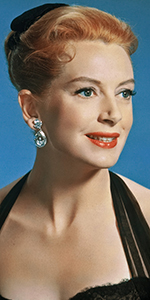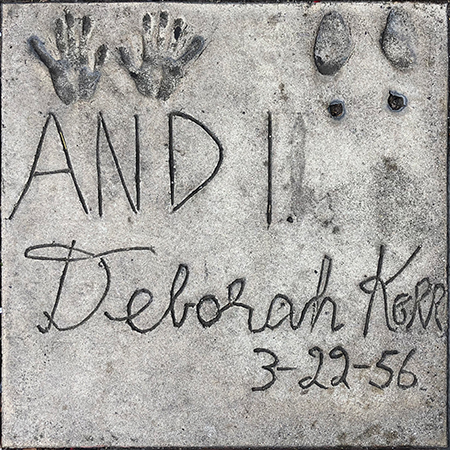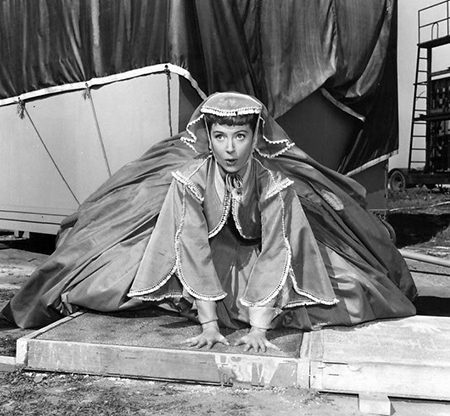 |
 |
 |
 |
 |
| Deborah Kerr, date unknown. |
| |
|
 |
|
 |
| |
| |
| |
| |
| |
| |
| |
| |
|
|
| Deborah Kerr with Yul Brynner |
 |
Ceremony held on Thursday, March 22, 1956
(at the 20th Century-Fox Studios)
|
| |
Born: Deborah Jane Kerr-Trimmer, September 30, 1921, in Glasgow, Scotland
Age at the time of the ceremony: 34
Died: October 16, 2007 in Botesdale, Suffolk, England, age 86 |
| |
Debroah Kerr was a very popular leading lady in England and America during the 1940s, 1950s, and 1960s. Gifted with an alluring intensity, Kerr excelled in roles requiring her to give it all she had — which was considerable.
Kerr-Trimmer was born to Kathleen Rose and to Capt. Arthur Charles Kerr-Trimmer, a World War I veteran, then practicing naval architecture. Deborah was educated at Northumberland House, at Henleaze in Bristol, and at Rossholme School in Weston-super-Mare. Originally training for the dance, young Deborah decided on acting, trainging with her Aunt Phillys Smale, who ran an acting school in Bristol. She made her debut at her school as Harlequin in Harlequin and Columbine in 1937.
After joining the Open-Air Theatre in London, she joined the Oxford Playhouse in 1940. At the age of 21, Kerr enjoyed a smashing West End debut in a revival of G. B. Shaw's Heartbreak House in 1943. She toured extensively in the British Isles until the end of World War II.
Kerr entered films with Love on the Dole (released in April 1941), and Hatter's Castle (released in February 1942) with James Mason. She then played a Norwegian resistance fighter in The Day Will Dawn (released in June 1942). This girl was boxoffice. Kerr had a triple role in Powell and Pressburger's The Life and Death of Colonel Blimp (released in June 1943), telling her directors that, if offered a chance to go to Hollywood, she would. Her agent sold her contract to M-G-M, but Kerr remained in England to make Black Narcissus (released in May 1947), which brought her all the attention from Hollywood you could ask for.
After finishing Edward, My Son (released in March 1949), in England, she went to Africa to shoot King Solomon's Mines (released in November 1950), then Rome for Quo Vadis (released in November 1951, which became the biggest hit of that year). She finally went to Hollywood to appear as Portia in Julius Caesar (released in June 1953) with Marlon Brando as Mark Anthony, then performed one of her signature roles as Karen Holmes in From Here to Eternity (released in August 1953).
Kerr made her Broadway debut in Tea and Sympathy with Elia Kazan directing, from September 1951 to June 1955, and starred in the film version, released in September 1956. She also toured with the play. Kerr was a big enough star to be top-billed over Yul Brynner in the film version of the Broadway mega-hit musical The King and I (which World Premiered at the Chinese in June 1956). Sometime during the shooting of King, the Chinese sent blocks of cement out to the busy 20th Century-Fox studio to get the imprints of both Kerr and Brynner.
Enjoying playing wildly different roles, Kerr played a nun again in Heaven Knows, Mr. Allison (which World Premiered at the Chinese in March 1957), then starred opposite Cary Grant in An Affair to Remember (which played the Chinese in July 1957). She had a significant role in the intimate film Separate Tables (released in December 1958), and teamed up with Yul Brynner again in The Journey (released in February 1959). She then played columnist Sheilah Graham to Gregory Peck's F. Scott Fitzgerald in Beloved Infidel (played the Chinese in November 1959).
More globe-trotting roles followed: an Australian sheephearder's wife in The Sundowners (released in December 1960); appeared with Cary Grant again in The Grass Is Greener (released in December 1960); then appeared as a governess loosing her mind in The Innocents (released in November 1961).
She took a break from films for a few years, returning as Hannah in the drama The Night of the Iguana (released in June 1964), and the comedy Marriage on the Rocks (released in September 1965) with Dean Martin and Frank Sinatra.
She accepted a role in the "James Bond" film Casino Royale (released in April 1967), then felt she was pressured into doing a nude scene in The Gypsy Moths (released in August 1969), which she found distasteful. So distasteful in fact, that
Kerr spent a fair part of the early 1970s performing in the West End, appearing in The Day After the Fair, Overheard, and The Corn Is Green.
In 1975, Kerr returned to Broadway in Edward Albee's Seascape, with Albee directing, then in 1977, she played the title role in a West End production of G. B. Shaw's Candida.
Switching to television, Kerr played Nurse Plimsoll to Ralph Richardson's Sir Wilfred in Witness for the Prosecution on CBS in December 1982. She then excelled as the lead character in the mini-series A Woman of Substance over Channel 4, airing in January 1985, then reunited with old friend Robert Mitchum in the TV movie Reunion at Fairborough, airing over HBO, in May 1985). Her last credit before retiring was the mini-series Hold the Dream, a follow-up to A Woman of Substance, airing on Channel 4, in November 1987).
Retiring to the English countryside to be close to her family, Kerr died from Parkinson's disease in October 2007, at the age of 86. |
|
|
|
|
| |
 |
 |
| Grauman's Chinese Theatre, Hollywood, California. Deborah Kerr Forecourt block. Executed by John Tartaglia at the 20th Century-Fox Studios, West Los Angeles, California, Thursday, March 22, 1956. 36 x 36 inches. |
 |
 |
 |
| 20th Century-Fox Studios, Los Angeles, California. Deborah Kerr Footprinting ceremony, Thursday, March 22, 1956. Deborah Kerr is surprised by the concrete while making her impressions outside a King and I soundstage. |
|
 |
|